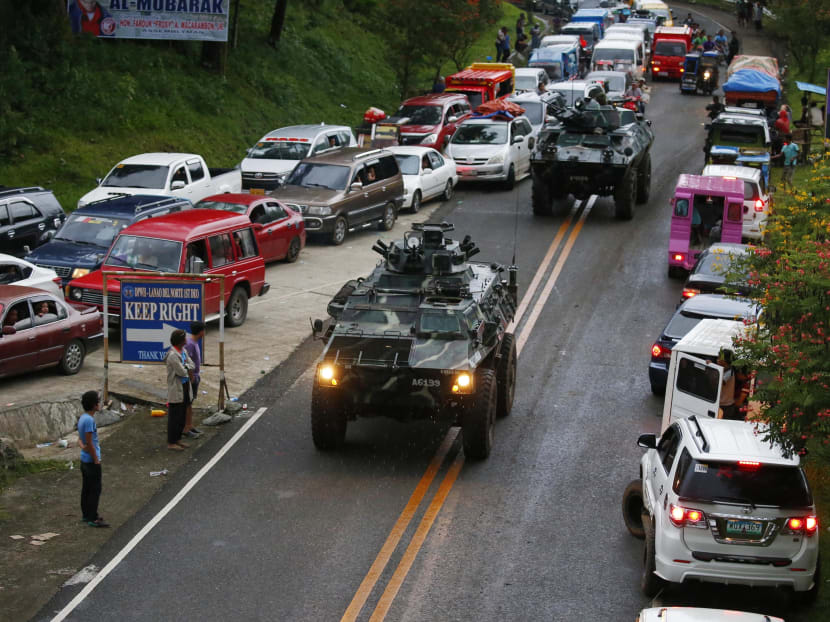The latest unrest in the southern Philippines, explained
MANILA — Philippine troops using tanks and helicopters stormed the southern city of Marawi on Thursday (May 25) in an effort to defeat militants linked to the Islamic State (IS) who have besieged the city for days, setting fire to buildings and taking hostages.

Armored personnel carriers making their way through a queue of vehicles with fleeing residents as militants lay siege to Marawi city in southern Philippines. Photo: AP
MANILA — Philippine troops, with the help of tanks and helicopters, are currently engaged in a fierce campaign in in the southern city of Marawi to defeat Islamist militants, who have besieged the city for days, setting fire to buildings and taking hostages.
Here is a look at what is happening and who is involved.
WHAT IS HAPPENING
On Tuesday (May 23), security forces in Marawi tried and failed to capture Isnilon Hapilon, an Islamist militant on the Federal Bureau of Investigation’s list of most-wanted terrorists. They were confronted by at least 100 militants, some of whom carried sophisticated weapons.
Many of those militants, members of a gang known as the Maute, then joined forces with Hapilon’s followers in a rampage through the city of 200,000. Both the Maute and Hapilon’s organisation, Abu Sayyaf, have pledged allegiance to IS, and fighters have raised that group’s black banner over several buildings in Marawi, including the city’s main hospital.
They have also taken a priest and his parishioners hostage and set fire to buildings. Thousands of civilians have fled the fighting, and at least 30 people have been killed.
On Tuesday, President Rodrigo Duterte imposed martial law on the southern island of Mindanao, which includes Marawi. Mindanao, home to 20 million people, is the heart of the country’s long-simmering Muslim insurgency.
WHO ARE THE KEY PLAYERS
Abu Sayyaf and Isnilon Hapilon
Abu Sayyaf is a jihadi group that has terrorised the southern Philippines for decades, engaging in piracy, kidnapping, extortion, and bombings. The group beheaded a German hostage this year and killed two Canadians in 2016.
The group says it wants to establish an Islamic caliphate in the southern Philippines. Last year, Hapilon, a Muslim preacher and an experienced guerrilla, pledged his allegiance to IS and its leader, Abu Bakr al-Baghdadi, in a video posted online.
The United States has offered a US$5 million (S$6.93 million) reward for Hapilon’s capture. In January, the Philippine military tried to kill him in an airstrike, but he was only wounded.
Hapilon has been trying to unite several smaller Islamist groups in the region, including the Maute, whose members are mostly in Marawi.
Maute
The Maute are another of the four Islamist groups in the region affiliated with the Islamic State. The group, founded by brothers Abdullah and Omar Maute, started as a small band of petty criminals.
Last year, members of the Maute were arrested in connection with a bombing at a night market in Davao City, Mr Duterte’s hometown. The authorities also said they foiled a plot in November in which the group tried to bomb the US Embassy in Manila.
President Rodrigo Duterte
Mr Duterte cut short a trip to Russia this week to oversee the military operation and declared martial law in Mindanao.
The populist president has taken an extreme hardline on crime and disorder, most notably with his contentious war on drugs, which has left thousands across the country dead and has drawn condemnation from rights groups and many Western governments. On Wednesday (May 24), Mr Duterte warned that he might impose military rule over the rest of the country, citing the possibility that terrorists could begin operations in the northern Philippines.
HOW DOES MARTIAL LAW WORK?
Tuesday’s declaration of martial law effectively replaced the civilian government in Mindanao with the armed forces. Under the declaration, soldiers have increased latitude to carry out arrests.
For two months, civil liberties will be curtailed. Civilians can be held in detention merely on suspicion of committing a crime and can be subjected to trial by military tribunal.
Mr Duterte’s threat to expand martial law nationwide is unnerving for many in the Philippines who lived through the dictator Ferdinand E. Marcos. Marcos declared martial law in 1972 and used it to maintain his grip on power for years. THE NEW YORK TIMES






